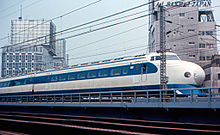
Tsing Ma Bridge is a bridge in Hong Kong. It is the world's 16th-longest span suspension bridge, and was the second longest at the time of its completion. The bridge was named after the two islands it connects, namely Tsing Yi and Ma Wan. It has two decks and carries both road and rail traffic, which also makes it the largest suspension bridge of this type. The bridge has a main span of 1,377 metres (4,518 ft) and a height of 206 metres (676 ft). The span is the longest of all bridges in the world carrying rail traffic.

The West Rail line was a rapid transit line that formed part of the Mass Transit Railway (MTR) system in Hong Kong until 27 June 2021. Coloured magenta on the MTR map, the line ran from Tuen Mun to Hung Hom, with a total length of 35.7 kilometres (22.2 mi), in 37 minutes. The railway connected the urban area of Kowloon and the new towns of Yuen Long, Tin Shui Wai and Tuen Mun in the northwestern New Territories.

The Light Rail, also known as the Light Rail Transit (LRT), officially the North-West Railway, is a light rail system in Hong Kong, serving the northwestern New Territories, within Tuen Mun District and Yuen Long District. The system operates over 1,435 mmstandard gauge track, using 750 V DC overhead power supply. It was once one of four systems comprising the KCR network in Hong Kong, before the MTR–KCR merger in 2007. It has a daily ridership of about 483,000 people. The line is colour warm yellow on the map, formerly deep orange before the MTR–KCR merger.

Tuen Mun Road is a major expressway in Hong Kong which connects Tuen Mun with Tsuen Wan, within the New Territories. It is part of Hong Kong's Route 9, which circumnavigates the New Territories. Opened in 1978, it was once the major trunk route linking the northwest New Territories to urban Kowloon and is known for its frequent traffic jams and road accidents owing to its early design and heavy usage. As a result, speed limits have been enforced to 70–80 km/h (45–50 mph) due to geometric constraints.
Gammon Construction Limited is a Hong Kong construction and engineering contractor headquartered in Kwun Tong, Hong Kong. In addition to local construction projects, it is also involved in the construction and engineering of various projects in China and Southeast Asia.
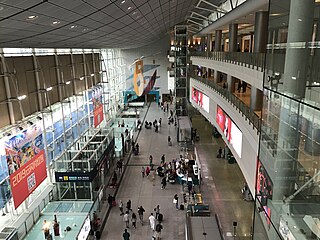
Hong Kong is a station of the MTR metro system in Hong Kong. It is the eastern terminus of the Tung Chung line and Airport Express. It is situated between Man Cheung Street and Harbour View Street, Central, Hong Kong Island, and sits underneath the International Finance Centre (IFC). It opened on 22 June 1998.

Tuen Mun Hospital is a public hospital, with a 24-hour accident and emergency department, in Tuen Mun, New Territories, Hong Kong. Its construction began in 1979, and it was inaugurated on 8 March 1990. It is governed by the Hospital Authority, and is designated under New Territories West Cluster.

Tuen Mun New Town, commonly referred to simply as Tuen Mun, is a satellite town of Hong Kong. It is one of the new towns that were developed by the Hong Kong Government in the New Territories from the 1960s. It was built around the existing rural local centre of Tuen Mun, which has since been referred to as the Tuen Mun Kau Hui and the Tuen Mun San Hui. The new town covers most of the urban area of Tuen Mun District.

North Lantau Highway is an expressway forming part of Hong Kong's Route 8, linking Hong Kong International Airport and Lantau Island with the rest of the territory. The road has three lanes in each direction for its entire length with full-width hard shoulders for emergencies and breakdowns. The speed limit is 110 kilometres per hour (68 mph) for most of its length, the highest of any road in Hong Kong.
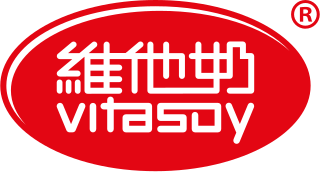
Vitasoy is a Hong Kong beverage company. It hosts a brand of beverages and desserts named Vita. Founded in 1940, it now operates under the Vitasoy International Holdings Limited. Its headquarters are in Tuen Mun, New Territories, Hong Kong.
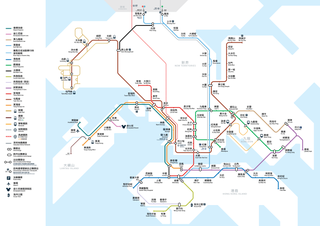
Several future projects on the MTR have been put forward by the MTR Corporation to the Hong Kong Government. Some of these are still in planning stage.
San Fat Estate was the first public housing estate in Tuen Mun, New Territories, Hong Kong, located on reclaimed land near the Tuen Mun River, at the junction of Pui To Road and Tuen Mun Heung Sze Wui Road. It consisted of four residential blocks completed in 1971, offering 2,131 flats with more than 6,000 residents. It was the smallest rental estate in Tuen Mun. Currently it is rebuilt as the MTR property development project “Century Gateway”.

Tuen Mun Park, formerly known as Tuen Mun Town Park, is located in Tuen Mun, Hong Kong. It is the largest town park in the New Territories, covering 12.5 hectares.
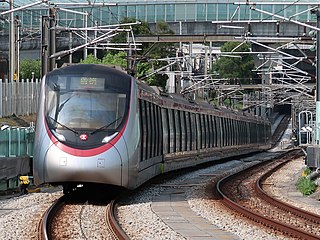
The Tuen Ma line is a rapid transit line that forms part of the Mass Transit Railway (MTR) system in Hong Kong. Coloured brown on the map, the Tuen Ma line is 56.2 kilometres (34.9 mi) in length, making it the longest line of the MTR network. It has a total of 27 stations, more than any other in the MTR system.

Hin Keng is a station on the Tuen Ma line, part of the MTR rapid transit network in Hong Kong. It opened on 14 February 2020 as part of the Tuen Ma line's first phase. It was built as part of the Sha Tin to Central Link project. The station is located near Hin Keng Estate in Tai Wai, Sha Tin, New Territories. It is an elevated station with one entrance facing Che Kung Miu Road.

The Royal Park Hotel, established in 1989, is one of the largest hotels in Sha Tin, New Territories, Hong Kong. Owned by Sun Hung Kai Properties, the 443-room hotel is part of phase two of New Town Plaza, the largest shopping centre in the district.
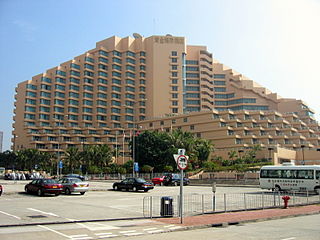
Hong Kong Gold Coast is a private housing estate served by Castle Peak Road, near Castle Peak Bay, in So Kwun Wat, Tuen Mun, New Territories, Hong Kong. Developed by Sino Group, it includes 20 residential buildings completed in two phases, a resort hotel, a shopping mall, a yacht and country club, a marina and a beach.

The Tuen Mun–Chek Lap Kok Link is a road project in the New Territories, Hong Kong. It comprises two elements: the "Northern Connection" and the "Southern Connection". The Northern Connection comprises an undersea tunnel crossing the Urmston Road, linking Tuen Mun to the "Boundary Crossing Facilities" (BCF), an artificial peninsula connected to Hong Kong International Airport. The Southern Connection, officially named Shun Long Road (順朗路), comprises viaducts linking the BCF to North Lantau Highway on Lantau Island.

Yan Tin Estate is a public housing estate in Tuen Mun, New Territories, Hong Kong located behind Siu Hong Court. It consists of five residential blocks, ranging in height from 33 to 38 storeys, and the Yan Tin Shopping Centre. It provides 4,688 rental flats catering to an approximate population of around 13,000. Tenant intake began on 23 March 2018.
A16 is an MTR station on the Tuen Ma line to be constructed elevated on the bank of Tuen Mun River at the current site of Tuen Mun Swimming Pool in Tuen Mun Area 16. The construction of the station is gazetted as part of the Tuen Mun South extension by the Hong Kong Government in January 2022. The station is expected to open for service in 2030.

